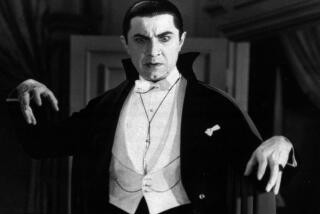At Gettysburg, a bloodthirsty army returns
99 Coffins
A Historical Vampire Tale
David Wellington
Three Rivers Press: 304 pp., $13.95 paper
*
THE vampire novel is, if nothing else, adaptable. Bram Stokerâs âDracula,â the absolute foundation of 20th century Nosferatu fiction, was a crudely constructed gothic page-turner that has unexpectedly weathered more than a century, multiple movies and generations of readers.
It was also a wholly uncritical metaphor for Victorian patriarchal sexism, xenophobia and racism. Anne Rice amassed an obsessive, black nail-varnished 1980s following with her vastly successful âVampire Chroniclesâ by conjuring a languidly gothic homoerotica punctuated by bouts of burning and bloodletting. In her wake, crowds of paperback writers created a lurid subgenre of hot-breath romances with added fangs.
David Wellington, with his novel â13 Bulletsâ and his latest, â99 Coffins,â the first two parts of a planned trilogy, is moving the literature of the undead into the 21st century with new levels of brutality.
The central character in â99 Coffins,â Laura Caxton, voices Wellingtonâs clear contempt for the sympathy-for-the-demon-style of author, pioneered by Rice, who found vampires infinitely more interesting than their human victims and their adversaries:
âDid he even know what a real living vampire was capable of? Most people didnât. Most people seemed to think they were like paler versions of Romantic poets. That they dressed in lace shirts and sipped red wine. That they would deign, from time to time, to nibble at somebodyâs neck with delicate little fangs.â
Wellingtonâs vampires are voracious, near-invincible humanoid sharks who rip, tear and mutilate to consume the gallons upon gallons of blood required for their survival.
And the lone protector who keeps them at bay here is Pennsylvania State Trooper Caxton -- whose character owes a decided debt of gratitude to Clarice Starling from Thomas Harrisâ âThe Silence of the Lambsâ and maybe Ellen Ripley from the movie âAlienâ -- except Caxton is openly gay, with a lover, Clara, who hardly ever sees her because Caxton is too busy defending humanity against the undead.
Caxton made her bones in â13 Bullets,â in which her accidental encounter with a vampire causes her to become the apprentice of Special Deputy Jameson Arkeley, the federal expert on vampires. In â99 Coffins,â an archaeological dig unearths 100 vampire coffins buried beneath a gunpowder bunker on the Gettysburg battlefield. But Arkeley is so mauled from the first book that Caxton is forced to take charge when one of the coffin occupants is discovered missing and presumably alive.
A bizarre tale unfolds, in a combination of present day narrative plus fictional letters and documents of the Civil War before and during the Battle of Gettysburg, when some lateral-thinking Union officers under Gen. Joseph Hooker hatched an occult scheme to create a force of supernatural guerrillas to decimate the Confederates. These unholy night-stalkers were never deployed but were concealed underground -- dormant -- ready to be reanimated and inflict bloody havoc.
The Caxton character drives the action, but her modernity prevents Wellingtonâs writing from benefiting from any trace of old-school gothic. His style is a violent police procedural, married loosely to the supernatural. When high climactic hell breaks loose and Caxton assumes command of National Guard veterans of Iraq and even helicopters to battle the hundred hungry vampires, Wellington retreats to a militarized form of toned-down splatter punk. His vampires are simply too super human -- stronger, faster and able to be killed only by a bullet directly through the heart.
Also, Wellingtonâs delight in high-tech combat hardware tends, unless handled carefully, to conflict with his sparse paranormal.
This weak bond between the modern and the supernatural is the basic flaw of Wellingtonâs approach to vampire fiction. â99 Coffinsâ also suffers the inevitable disadvantage of the second part of a planned trilogy. It is already, one hopes, working with a fully formed back story, so the author is loath to break the narrative to refresh the readerâs memory, and then thereâs the temptation to finish with a tease for the next book.
The problem is that â13 Bulletsâ hardly establishes any credibly detailed rationale as to why Wellingtonâs vampires exist and fails to explain how an otherwise highly realistic modern world accepts them as frightening and dangerous but without the slightest surprise at their existence. One charm of the vampire genre is that its dramas play out within a framework of rules based mainly on Eastern Europe folklore as interpreted by Stoker. The vampire is incinerated by the sun, it must sleep in its personal coffin, it cannot cross water, it fears religious symbols and is killed by a stake through the heart.
These basics are manipulated and at times selectively discarded to suit an authorâs purpose, but all vampire writers know rules are essential. The vampire is ultimately superhuman, higher on the food chain, and every Superman needs his Kryptonite for the story to function.
While Wellingtonâs vampires do expire in the sun, he has an original device whereby they can be immobilized by removing their hearts from their bodies and resuscitated should the heart be replaced. Itâs deft but lacks even a sketch of an explanation. The traditionalists will undoubtedly disapprove and demand a more robust and structured fantasy, but because Wellington has amassed an online cult, he may have proved that his readership simply requires chills and action and not occult intricacy or vampire crypto-biology. Itâs a new century, and perhaps even the immortal have to change with the times.
--
Mick Farren is the author of âThe Renquist Quartet,â a set of vampire novels in a contemporary setting.
More to Read
Sign up for our Book Club newsletter
Get the latest news, events and more from the Los Angeles Times Book Club, and help us get L.A. reading and talking.
You may occasionally receive promotional content from the Los Angeles Times.








